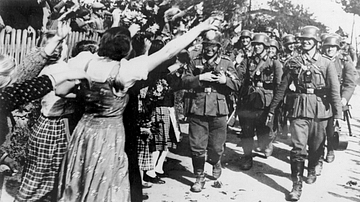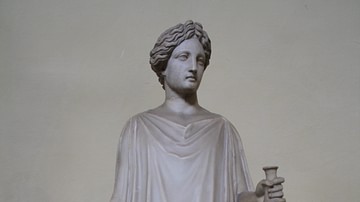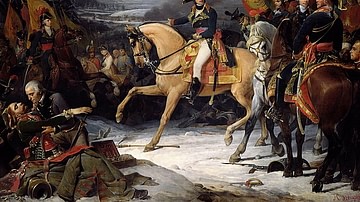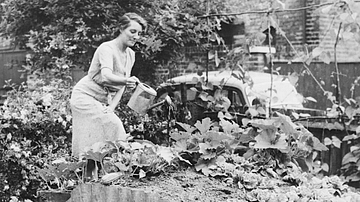In 2024, France is celebrating the 80th anniversary of the Liberation (1944), and as part of a series of conferences organised by the Société archéologique et historique de Beaugency, Catherine Join-Dieterle, Doctor in History of Art and General Curator of Cultural Heritage, gave a fascinating talk titled Fashion in France under the German Occupation. In this exclusive interview, Ms Join-Dieterle talks more on this subject to Babeth Étiève-Cartwright, revealing a subject that really is a lot less frivolous than it seems.

BEC: Catherine Join-Dieterle, on behalf of World History Encyclopedia, I would like to thank you for agreeing to conduct this interview. When we hear about the German Occupation, we conjure up images that are far removed from the world of fashion and yet, fashion being a reflection of society, it played a sizeable role in those difficult years. Could you start by giving us some examples of how fashion evolved in France in the 1930s?
CJD: At the dawn of the 1930s, fashion had abandoned the short dress that had so marked the Roaring Twenties. Dresses and coats now reached mid-calf and the feminine figure, which had previously been suppressed, was now emphasised. Long, flowing dresses were worn in the evening, while suits and ensembles emphasised the waist. However, as the sound of boots grew more insistent, some designs were influenced by army outfits, with square shoulders, shako-inspired hats and the use of khaki. But there was also a much more optimistic trend, with designers such as Elsa Schiaparelli (1890-1973) and Christian Dior (1905-1957) proposing much more romantic and even surrealist outfits, influenced by artists such as Salvador Dali (1904-1989). We then saw the emergence of the shoe hat and fuller long dresses with vaporous sleeves were the order of the day.
BEC: So, what happened once the German Occupation was firmly established? The new political reality of course had many dramatic consequences on the lives of the French people, but what about fashion?
CJD: The German Occupation had many repercussions on fashion in France because of the conditions imposed on the French people. The occupying forces decided to take three-quarters of the country's production, so the French had to make do with what the Germans would be willing to let them have. Rationing was introduced, and the French were obliged to use ration coupons to buy supplies, including clothes. For example, this is what a woman was entitled to at the time:
- two dresses
- two aprons or blouses
- one mackintosh
- two pairs of winter gloves
- one winter coat
- three blouses
- two overalls
- three pairs of underpants
- six pairs of stockings
- six handkerchiefs
- one pair of flat shoes (which had to last four years).

Most women turned to sewing, their own resourcefulness (taking old jumpers apart), upcycling (believe it or not, this is not a recent innovation), and even the black market. With certain materials being extremely difficult to find (leather, for example), French creativity adapted by using new materials: wood for shoes, rayon (a textile fibre made from wood cellulose) for clothes and parachute fabric, which is extremely strong, to make men's shirts. Old fabrics lying around in stocks or attics were also reused (the tartan so popular in previous years made a remarkable comeback), and many outfits were in fact made up of different types of elegantly coordinated fabric.
From a stylistic point of view, fashion had to follow a new path; models became utilitarian, strict and responded to the harshness of living conditions. Outfits were therefore warmer (it was difficult to keep warm, and winters were particularly cold), quilted with cotton wool and more innovative to cope with scarcity. As it was difficult, if not impossible, to obtain leather, handbags became rare and we then saw the emergence of large pockets that made it possible to do without them. These could be sewn directly onto the garment or added using a separate belt. There was also a need for all-purpose clothing that could be used in all circumstances, and so the suit made its appearance, with a shorter skirt and a slit at the front to make it easier to ride a bicycle (petrol being a rare commodity, the bicycle experienced a remarkable boom at that time).
BEC: What about men's fashion?
CJD: There were also a lot of restrictions imposed on men. In 1942, suits and overcoats were no longer allowed to have gussets, box pleats or half-belts, and double-breasted waistcoats and knickerbockers were banned. Trousers were allowed only one pocket, and trouser cuffs were absolutely forbidden. All this to save fabric. Boys were no longer allowed to wear sailor collars and were obliged to wear short trousers until the age of 15.
BEC: All repression eventually has a reaction. Did the French rebel against these rules? Knowing the contesting nature of the French people, I can't bring myself to believe that they accepted all this without batting an eyelid!
CJD: Definitely! The French were quick to get round the rules! You can only buy one pair of flat shoes every four years? Whatever! We'll make wooden shoes with platform soles! Can't find stockings in the shops? No problem, women could resort to stitching or dyeing their legs with walnut oil (not forgetting the thin black line for the seam) ... there were even ready-made kits for this. Large bags were theoretically forbidden; however, carrier bags (some made from the superb cashmere scarves so many had inherited) were worn across the shoulders, very useful for stuffing products bought in shops whenever supplies came in, and if possible, double-bottomed bags, so that documents or other secret messages could be safely transported.
Fashion would also become a means of taunting the occupying Germans as well as a means of propaganda: hats, even though banned, would rise, to keep heads held high, patterns of blue, white and red fabric with words or slogans like travail, famille, patrie ("work, family, homeland") here and there for good measure, buttons in the shape of patriotic Gallic roosters. And then there were the zazous. This French term was used to describe those young people who had "an immoderate passion for American jazz music and who made a name for themselves with their eccentric dress" (Trésor de la langue française informatisé). It was, in fact, an international movement (they were called ‘zooters’ in the United States). The young men would wear baggy trousers (in the face of restrictions on fabric), wear their hair medium-length in reaction to short military haircuts, and the girls, who wore excessive make-up, would have short skirts and puffy hairdos. Needless to say, these young people were frowned upon by Marshal Pétain's moralistic regime!
BEC: So far, we've mainly talked about everyday fashion, the fashion of ordinary people. What about haute couture? Did designers have the right to work in their ateliers, but above all did they have the necessary means to do so?
CJD: Unfortunately, at the start of the Occupation, some major fashion houses had to close down, such as Vionnet (1876-1975) and Schiaparelli. Chanel (1883-1971) moved to the South of France before closing her house too. Young designers who had not yet opened their own houses, such as Pierre Balmain (1914-1982) and Christian Dior, were drafted in. From 1941 onwards, however, there was a resurgence of haute couture work, and French excellence became perceived by many as a form of resistance. Haute couture was also a key sector for the French economy because of the number of people involved. France was providing fashionable outfits for the beautiful ladies of the whole world! People bought their clothes in Paris or copied Parisian models! Unfortunately, shortages and bans made it impossible to publish photos of models in magazines, so we had to resort to illustrations in fashion magazines such as Mode du Jour, Silhouettes, and Marie-Claire.

However, if there is one name to remember in connection with haute couture during the German Occupation, it is that of Lucien Lelong (1889-1958), president of the Chambre syndicale de la haute couture (Haute Couture Trade Union Chamber), who did everything in his power to prevent the Germans from moving this economic sector to Germany. At the end of the war, to ensure that France regained its position as champion of fashion, Lelong and Robert Ricci (1905-1988, co-founder of the Fashion house Nina Ricci) initiated a travelling exhibition of miniature mannequins (70 cm or 27.5 in high) dressed by the top designers. This ‘theatre of fashion’ would travel the world for a whole year, signalling the return of French stylists and proving that, thanks to the incredible talent of many artists, French haute couture still deserved its place at the top of the international fashion league.
BEC: Of course, much more could be said on this subject, including the infamous yellow star imposed on French Jews, some of the designers who publicly flaunted their support for the German occupiers, and Coco Chanel's controversial stance, but perhaps all that will be the subject of a future conversation.
Thank you, Ms Join-Dieterle, for sharing your expertise with our readers. It is a fascinating topic and we are very grateful to you for providing us with the opportunity to learn so much about French fashion during the German Occupation. On behalf of everyone at World History Encyclopedia and our readers, thank you again for your valuable contribution.
Catherine Join-Dieterle has a doctorate in History of Art and is General Curator of Cultural Heritage. A leading fashion specialist, she was head of the Objets d'Art department at the Petit Palais from 1974 to 1988 and was later appointed Director of the Palais Galliera - Musée de la Mode de la Ville de Paris from 1989 to 2010. She has curated numerous exhibitions devoted to fashion, including ‘Robes du soir’ (1990), ‘Givenchy’ (1991), and ‘Marlene Dietrich’ (2003), among many others.






